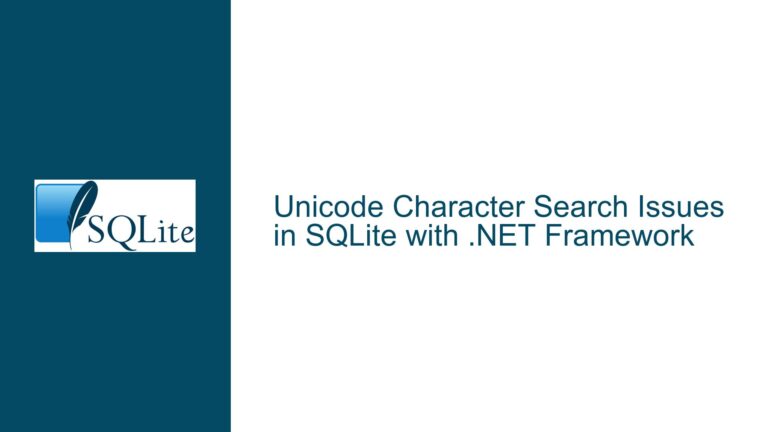Resolving Non-Sequential Primary Key Gaps in SQLite for External Application Integration
Issue Overview: Mismatched Database Keys and Application Index Requirements
When integrating SQLite databases with external applications, developers often encounter challenges where the database’s integer primary keys (IDs) don’t align with the application’s indexing requirements. This mismatch occurs when the application expects dense, sequential indices (e.g., 0,1,2,…) for efficient array/bitmask operations, but the database uses non-sequential or sparse IDs due to deletions, updates, or non-AUTOINCREMENT key generation.
In the discussed scenario, three tables exist:
- A filenames table with
idas the primary key. - A tags table with
idas the primary key. - A link table with foreign keys referencing
filenames.idandtags.idfor many-to-many relationships.
The C++ application processes this data using bitfields where each bit position corresponds to a tag ID. Non-dense database keys force the application to maintain translation layers (e.g., std::map) to map database IDs to bit positions, introducing complexity and performance overhead.
Key Challenges:
- Primary Key Behavior: SQLite’s
INTEGER PRIMARY KEYautomatically generates unique IDs but does not guarantee dense sequences. Deletions create gaps, and inserts reuse lower IDs only ifAUTOINCREMENTis omitted. - Foreign Key Dependencies: The link table’s foreign keys require cascading updates if primary keys are modified, complicating schema changes.
- Data Integrity Risks: Manually altering primary keys can corrupt relationships unless foreign key constraints are strictly enforced.
Possible Causes: Why Database Keys Become Non-Dense
1. Row Deletions
When rows are deleted, their IDs are not reused by default. For example, if rows with IDs 1, 2, 3 exist and row 2 is deleted, new inserts will use ID 4, leaving a gap.
2. Rollbacks and Transactional Integrity
Aborted transactions or rollbacks may reserve IDs temporarily, leading to gaps. SQLite’s ID counter increments even for failed inserts to maintain transactional isolation.
3. Explicit ID Insertions
Manually inserting rows with specific IDs (e.g., INSERT INTO filenames (id, name) VALUES (100, 'file.txt')) creates gaps if subsequent inserts use auto-generated IDs.
4. AUTOINCREMENT Keyword
Using AUTOINCREMENT prevents ID reuse but guarantees monotonically increasing values. Without it, SQLite may reuse lower IDs after deletions, but this is not predictable.
5. Application-Side Assumptions
Assuming database IDs will always match application indices is a design flaw. Applications should treat database keys as opaque identifiers and handle mapping internally or via SQL.
Troubleshooting Steps, Solutions & Fixes
Solution 1: Map Database Keys to Dense Indices During Query Execution
Instead of modifying the database, compute dense indices at query time using window functions. This approach preserves data integrity and avoids schema changes.
Step 1: Retrieve Filenames with Dense Indices
SELECT
row_number() OVER (ORDER BY id) - 1 AS cpp_index,
name
FROM filenames
ORDER BY id;
The row_number() OVER (ORDER BY id) generates a sequential index starting at 1. Subtracting 1 aligns it with zero-based C++ indices.
Step 2: Retrieve Tags with Dense Indices
SELECT
row_number() OVER (ORDER BY id) - 1 AS cpp_index,
tag
FROM tags
ORDER BY id;
Step 3: Resolve Link Table with Mapped Indices
Use Common Table Expressions (CTEs) to create temporary mappings:
WITH
filename_mapping AS (
SELECT
id AS db_id,
row_number() OVER (ORDER BY id) - 1 AS cpp_index
FROM filenames
),
tag_mapping AS (
SELECT
id AS db_id,
row_number() OVER (ORDER BY id) - 1 AS cpp_index
FROM tags
)
SELECT
f.cpp_index AS filename_idx,
t.cpp_index AS tag_idx
FROM link_table l
JOIN filename_mapping f ON l.filename_id = f.db_id
JOIN tag_mapping t ON l.tag_id = t.db_id;
Advantages:
- No schema modifications.
- Real-time mapping without altering the database.
- Handles dynamic data changes automatically.
Disadvantages:
- Adds overhead to queries.
- Requires updating application SQL statements.
Solution 2: Rebase Primary Keys Using Transactions
Modify the database to replace sparse IDs with dense indices. This requires careful transaction handling and foreign key updates.
Step 1: Enable Foreign Key Enforcement
Ensure foreign keys are enforced to maintain referential integrity:
PRAGMA foreign_keys = ON;
Step 2: Rebase Filenames Table
Create a temporary mapping of old-to-new IDs and update dependencies:
BEGIN IMMEDIATE TRANSACTION;
-- Create temporary mapping
CREATE TEMP TABLE filename_rebase AS
SELECT
id AS old_id,
row_number() OVER (ORDER BY id) - 1 AS new_id
FROM filenames;
-- Update foreign keys in the link table
UPDATE link_table
SET filename_id = (
SELECT new_id
FROM filename_rebase
WHERE old_id = filename_id
);
-- Rebuild filenames table with new IDs
CREATE TABLE new_filenames (
id INTEGER PRIMARY KEY,
name TEXT NOT NULL UNIQUE
);
INSERT INTO new_filenames (id, name)
SELECT
fr.new_id,
f.name
FROM filenames f
JOIN filename_rebase fr ON f.id = fr.old_id;
DROP TABLE filenames;
ALTER TABLE new_filenames RENAME TO filenames;
COMMIT;
Step 3: Repeat for Tags Table
Repeat the process for the tags table, ensuring the link table’s tag_id column is updated accordingly.
Advantages:
- Permanently resolves sparse IDs.
- Simplifies application logic by aligning database and application indices.
Disadvantages:
- Complex, error-prone process.
- Requires downtime during schema changes.
- May break external tools relying on original IDs.
Solution 3: Application-Side Mapping with Cached Lookups
Maintain bidirectional maps (database ID ↔ application index) in the application layer to avoid database modifications.
Step 1: Query Database IDs and Store in Containers
std::vector<int> filename_ids;
std::unordered_map<int, size_t> filename_id_to_index;
sqlite3_stmt* stmt;
sqlite3_prepare_v2(db, "SELECT id FROM filenames ORDER BY id", -1, &stmt, nullptr);
while (sqlite3_step(stmt) == SQLITE_ROW) {
int db_id = sqlite3_column_int(stmt, 0);
filename_id_to_index[db_id] = filename_ids.size();
filename_ids.push_back(db_id);
}
sqlite3_finalize(stmt);
Step 2: Convert Link Table Using Mappings
std::vector<std::bitset<MAX_TAGS>> file_tag_bitmask(filename_ids.size());
sqlite3_prepare_v2(db, "SELECT filename_id, tag_id FROM link_table", -1, &stmt, nullptr);
while (sqlite3_step(stmt) == SQLITE_ROW) {
int db_filename_id = sqlite3_column_int(stmt, 0);
int db_tag_id = sqlite3_column_int(stmt, 1);
size_t filename_idx = filename_id_to_index[db_filename_id];
size_t tag_idx = tag_id_to_index[db_tag_id];
file_tag_bitmask[filename_idx].set(tag_idx);
}
sqlite3_finalize(stmt);
Advantages:
- No database changes.
- Flexible handling of dynamic or external databases.
Disadvantages:
- Adds memory overhead.
- Requires synchronization if the database changes.
Final Recommendations
- Prefer Query-Time Mapping: Use window functions like
row_number()to avoid schema changes. - Avoid Primary Key Modifications: Rebasing IDs risks data corruption and complicates foreign key management.
- Isolate Database and Application Layers: Treat database keys as opaque identifiers and handle mappings in the application.
By understanding SQLite’s key management behavior and leveraging window functions or application-layer mappings, developers can bridge the gap between database IDs and application indices without compromising data integrity.






